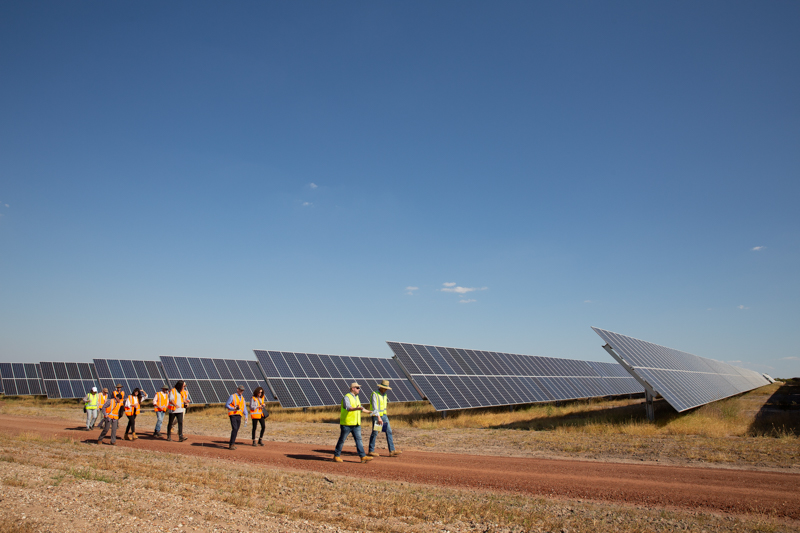Impact Investment Group (IIG) has taken the Queensland government to court over controversial regulations which apply to solar farms larger than 100 kW. The new rules require mounting, locating, fixing and removal of PV panels at solar farms to only be undertaken by licensed electricians.
The developers of the 35 MW Brigalow Solar Farm near Toowoomba in south-east Queensland have filed legal action at Queensland’s Supreme Court last Friday, only days after the new rules were signed into law. The Queensland government made the move despite warnings that the new regulations will put hundreds of local jobs at risk and could bring some projects to a standstill.
While it has not released any further details, it is quite likely that IIG has encountered difficulties in finding enough qualified electricians. Last month, Lane Crockett, the head of renewable infrastructure for IIG, told The Guardian the company had planned to hire 60 local labourers, who would be trained to install solar panels. Crockett expressed concern IIG might not be able to find enough fly-in fly-out electricians willing to carry out the manual work.
Support & criticism
The Clean Energy Council said it supported IIG’s legal action, but was ‘deeply disappointed’ there was a need for any company to pursue it in the first place.
“The Brigalow Solar Farm feels obliged to challenge the regulation through the courts because the industry has been unable to resolve the matter in discussions with the government since the regulation was announced in April,” said Anna Freeman, the CEC’s Director of Energy Generation.
While the Queensland government believes they have struck the right balance between meeting their goal of 50% renewable energy by 2030, and worker and community safety, installers have warned the “new safety code” was set to cost jobs, delaying installations and making some projects unviable. It has been suggested the new regulations could push up the cost of commercial and industrial solar systems by some 20%.
“In our view, this regulation will increase the costs of projects, reduce employment opportunities for local communities, and lead to a downturn in clean energy investment in Queensland, without delivering any safety benefit,” Freeman said.
Previously, the CEC pointed out that mounting of electrical equipment is not even classed as electrical work under the state Electrical Safety Act (2002), and it could easily be performed by local labourers and trades assistants. Master Electricians Australia have also voiced sharp criticism over this decision.
“These new regulations add nothing but red tape to solar farm installations. They don’t enhance safety, they don’t improve performance and they don’t boost clean energy production,” MEA Chief Executive Officer Malcolm Richards said. “What they will do is drive up the cost of building a new solar farm, and tie up electrical businesses in unnecessary regulation.”
IIG Solar Asset Fund
The 35 MW Brigalow Solar Farm broke ground in January this year and is currently under construction. The project was developed by UK-based Eco Energy World and acquired by IIG for their Solar Asset Fund in November.
IIG’s Solar Asset Fund offers investors a portfolio of large-scale solar projects that sell electricity into Australia’s spot markets. It opened for the first time last May securing more than enough commitments to fund the first two assets: the Swan Hill and the Chinchilla solar farms. The 19 MW Swan Hill Solar Farm reached practical completion in July 2018, and the 20 MW Chinchilla Solar Farm started sending electricity into the market late last year.
The IIG Solar Asset Fund opened for new investments in January this year coinciding with the start of construction works on the Brigalow Solar Farm.
This content is protected by copyright and may not be reused. If you want to cooperate with us and would like to reuse some of our content, please contact: editors@pv-magazine.com.









2 comments
By submitting this form you agree to pv magazine using your data for the purposes of publishing your comment.
Your personal data will only be disclosed or otherwise transmitted to third parties for the purposes of spam filtering or if this is necessary for technical maintenance of the website. Any other transfer to third parties will not take place unless this is justified on the basis of applicable data protection regulations or if pv magazine is legally obliged to do so.
You may revoke this consent at any time with effect for the future, in which case your personal data will be deleted immediately. Otherwise, your data will be deleted if pv magazine has processed your request or the purpose of data storage is fulfilled.
Further information on data privacy can be found in our Data Protection Policy.